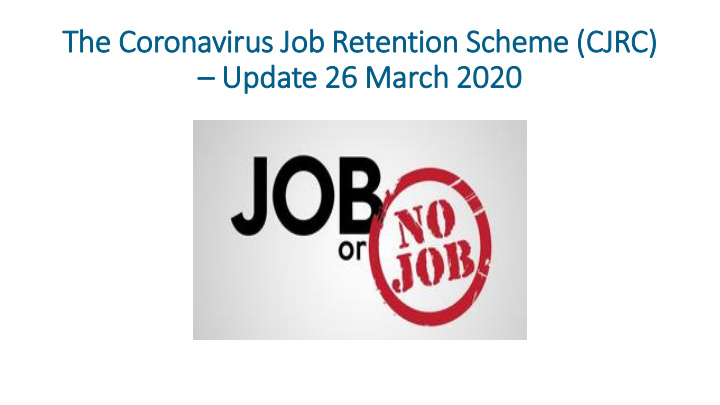



The Cor oronavirus Job Job Retention Sc Scheme (CJRC) ) – Update 26 Mar arch ch 2020
Obje jectiv ives • An overview of the CJSC • Practical guidance • Our support TO YOU
Government t Su Support t – Su Summary The package of measures to support businesses includes: • Coronavirus Job Retention Scheme. • Deferring VAT and Income Tax payments. • A Statutory Sick Pay relief package for SMEs. • A 12-month business rates holiday for all retail, hospitality and leisure businesses in England. • Small business grant funding of £10,000 for all business in receipt of small business rate relief or rural rate relief (regional variances). • Grant funding of £25,000 for retail, hospitality and leisure businesses with property with a rateable value between £15,000 and £51,000 (regional variances). • The Coronavirus Business Interruption Loan Scheme offering loans of up to £5 million for SMEs through the British Business Bank. • A new lending facility from the Bank of England to help support liquidity among larger firms, helping them bridge coronavirus disruption to their cash flows through loans. • HMRC Time To Pay Scheme.
Cor oronavirus Job Job Retentio ion Sc Scheme (CJR CJRS) All UK employers will be able to access support to continue paying part of their employees’ salary for those employees that would otherwise have been laid off during this crisis. All UK businesses are eligible. You will need to: • designate affected employees as ‘furloughed workers,’ and notify your employees of this change - changing the status of employees remains subject to existing employment law and, depending on the employment contract, may be subject to negotiation • submit information to HMRC about the employees that have been furloughed and their earnings through a new online portal (HMRC will set out further details on the information required) HMRC will reimburse 80% of furloughed workers wage costs, up to a cap of £2,500 per month. HMRC are working urgently to set up a system for reimbursement. Existing systems are not set up to facilitate payments to employers.
The Sp Spir irit it of of The CJR CJRS: • UK employers with a PAYE • HMRC will reimburse 80% of their scheme will be able to access wages up to £2500 max per month support to continue paying part of • This safeguards workers from their employees’ salary for those being made redundant that would otherwise have been • Covers the cost of wages laid off during this crisis. This backdated to 1ST March and is applies to employees who have initially open for 3 months but will been asked to stop working, but be extended if necessary. who are being kept on the payroll, otherwise described as “furloughed workers”.
How Will ill It It Wor ork In In Practic ice? • Employers will need to designate • Keep a list of Furloughed affected employees as ‘furloughed employees and details of pay, NI, workers’ and notify those names etc. employees of this change and • Do payroll using 80% of salary agree this with them • Pay employees (albeit 80% of • May need to discuss and agree usual pay) with employees to Furlough • Furloughed employees should not • Notify employees in writing with do ANY work for the employer reasons • In April HMRC portal to reclaim • 80% or full wage – employer 80% paid to Furloughed chooses (max £2500) employees
Ex Example les • Lucky Ltd employs Mr Busy at an annual salary of £24,000 (£2,000 per month). (Ignore pensions and AE) • Each month, Mr Busy receives net pay of £1,665 which is after deducting PAYE of £191 and employees NIC of £144. On this salary, the employer pays employers' NIC of £174. • The available grant for the employer is the lower of: • (a) 80% of (£2,000 + £174), and • (b) £2,500 • So a grant of £1,739 in April when the systems are working
What Act ctio ions Sh Should You ou Tak ake Now? • See the Small Business Emergency Action Plan • You must have some figures of where you are and what effect the Pandemic will have on your cash flow • Then you can make decisions
Im Immediate Act ctio ions • Work out your estimated sales and costs over the next 3 months and Break even point and do a Cash Flow Forecast - You need these to make decisions: • Talk to your bank if you have loans or an overdraft • Apply (if necessary) for Government and Bank support • Above all stay strong! Remember your health and welfare is more important than anything else just now. We will help you every step of the way. Together we will beat this!
Resources Available: : Cas ash Flo Flow, Break even and “What if “ tools
What’s Next? • The situation is changing daily • Get your Action Plan in place • Know your figures and make projections for the next 3 months • Apply for Government or bank support (if applicable) • Be strong and above all look after your and your families Health. • We are with you all the way – our business depends on you.
Ple lease con ontact us s for or fu further in informatio ion
Recommend
More recommend